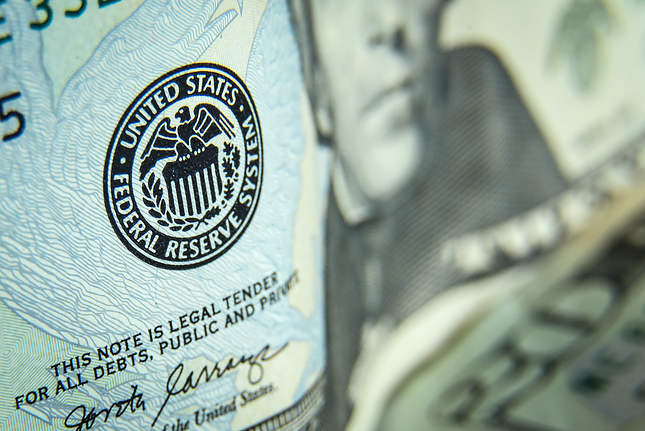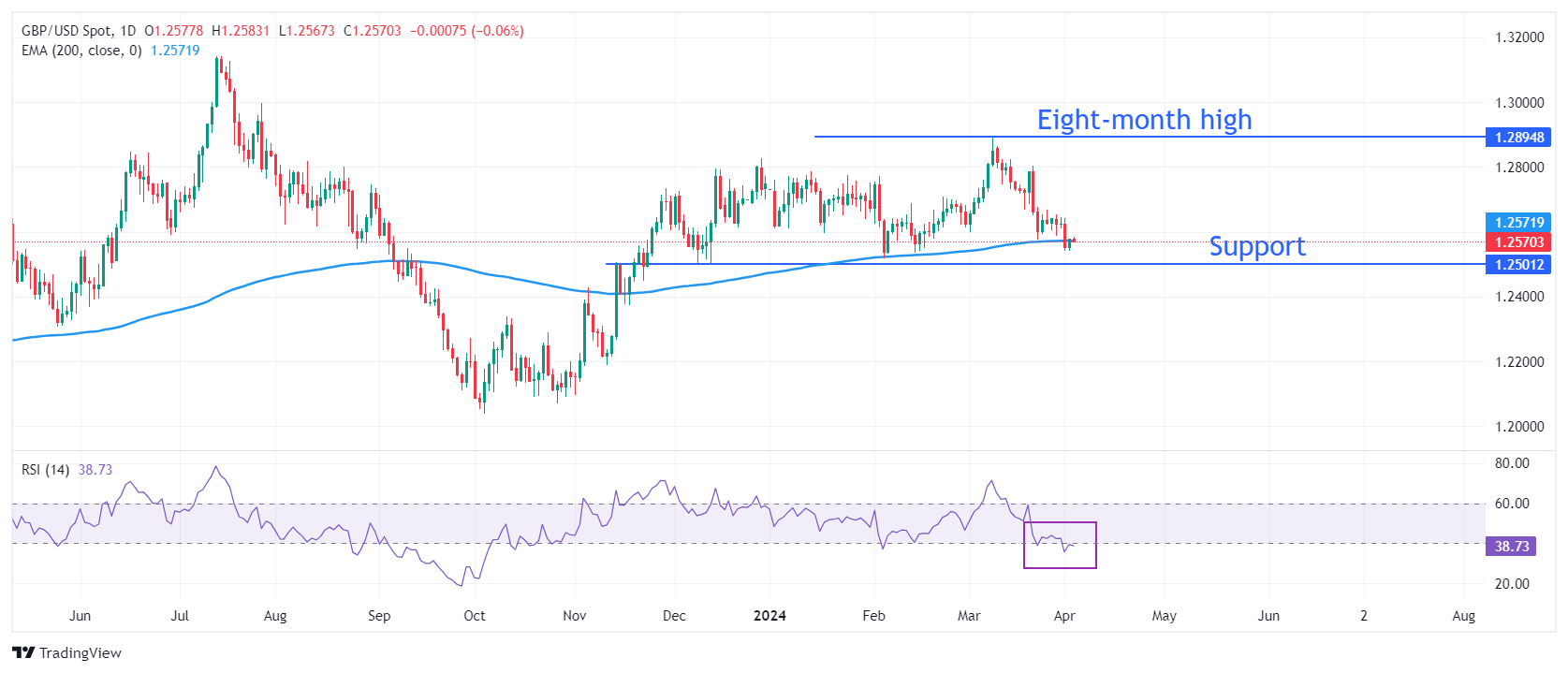- The Pound Sterling capitalizes on risk-on mood and rises to 1.2660.
- UK’s upbeat Manufacturing PMI data and increasing home prices suggest that the UK recession was shallow.
- The US NFP data will guide the next move in the US Dollar.
The Pound Sterling (GBP) aims to extend its recovery above the one-week high of 1.2660 in Thursday’s early New York session. The GBP/USD pair exhibits strength as recent economic indicators in the United Kingdom have shown that the economy is on track to return to growth after falling into a technical recession in the second half of 2023. Meanwhile, a weaker US Dollar due to the poor United States Institute of Supply Management (ISM) Services PMI data for March also boosted the Cable.
The UK’s Manufacturing PMI surprisingly expanded in March after contracting for 20 straight months, driven by robust domestic demand. Strong UK factory data propelled business optimism to its highest level since April 2023, with 58% of manufacturers expecting their production level to increase over the coming 12 months. In addition, British house prices rose 1.6% in March, the highest pace since December 2022, suggesting that the real estate sector is holding up despite historically higher interest rates.
In the European session, the latest Bank of England (BoE) Decision Maker Panel (DMP) survey for February showed that most firms see selling prices and wage inflation cooling down over the next year. Selling price expectations decelerated to 4.1% from 4.3%, the lowest reading in over two years. Wage growth expectations softened to 4.9% on a three-month moving average basis from 5.2% in February.
Daily digest market movers: Pound Sterling continues winning spell
- The Pound Sterling advances to 1.2660 against the US Dollar. The asset extends the upside as the market sentiment is bullish, and a weak United States ISM Services PMI has knocked down the US Dollar. The S&P 500 opens on a positive note in Thursday's session.
- On Wednesday, the US Services PMI surprisingly fell to 51.4 in March from expectations of 52.7 and the former reading of 52.6. The Services PMI gauges business activity in the service sector, which accounts for two-thirds of the US economy. Therefore, the impact of a poor Services PMI was significantly adverse for the US Dollar, dragging the US Dollar Index (DXY) by more than 0.5% to 104.15. The ISM report also showed that new orders and prices paid subindexes fell significantly.
- This week, the major driver for the US Dollar will be the US Nonfarm Payrolls (NFP) report for March, which will be published on Friday. The economic data will significantly impact market expectations about whether the Federal Reserve will start reducing interest rates from the June meeting. The NFP report is expected to show that 200K workers were hired over the month, lower than February’s reading of 275K.
- On the UK front, the Pound Sterling will be guided by market expectations over Bank of England rate cuts. Investors expect the BoE to kick-start the rate-cut cycle in June as the United Kingdom inflation is slowing consistently. For the whole year, BoE Governor Andrew Bailey said he sees two or three rate cut expectations as “reasonable.”
- Meanwhile, S&P Global/CIPS has reported that Services PMI failed to meet expectations in Marc. The Services PMI falls to 53.1, from expectations and the prior reading of 53.4. Tim Moore, Economics Director at S&P Global Market Intelligence, said, "The recovery in service sector output lost a little bit of momentum during March, and more so than suggested by the flash PMI results, but the overall picture remains reasonably positive.
Technical Analysis: Pound Sterling prints fresh weekly high at 1.2680
The Pound Sterling rebounds to a one-week high near 1.2660 after discovering buying interest from a six-week low of 1.2540. The GBP/USD pair continues its winning spell for the third trading session on Thursday. Cable bulls respected the 200-day Exponential Moving Average (EMA) at 1.2566. The 20-day EMA near 1.2660 could act as a strong barrier ahead.
On a broader time frame, the horizontal support from December 8 low at 1.2500 would provide further cushion to the Pound Sterling. Meanwhile, the upside is expected to remain limited near an eight-month high of around 1.2900.
The 14-period Relative Strength Index (RSI) rebounds above 40.00 after slipping below it. The event should not be considered a “bullish reversal” until it decisively breaks above 60.00.
Interest rates FAQs
Interest rates are charged by financial institutions on loans to borrowers and are paid as interest to savers and depositors. They are influenced by base lending rates, which are set by central banks in response to changes in the economy. Central banks normally have a mandate to ensure price stability, which in most cases means targeting a core inflation rate of around 2%. If inflation falls below target the central bank may cut base lending rates, with a view to stimulating lending and boosting the economy. If inflation rises substantially above 2% it normally results in the central bank raising base lending rates in an attempt to lower inflation.
Higher interest rates generally help strengthen a country’s currency as they make it a more attractive place for global investors to park their money.
Higher interest rates overall weigh on the price of Gold because they increase the opportunity cost of holding Gold instead of investing in an interest-bearing asset or placing cash in the bank. If interest rates are high that usually pushes up the price of the US Dollar (USD), and since Gold is priced in Dollars, this has the effect of lowering the price of Gold.
The Fed funds rate is the overnight rate at which US banks lend to each other. It is the oft-quoted headline rate set by the Federal Reserve at its FOMC meetings. It is set as a range, for example 4.75%-5.00%, though the upper limit (in that case 5.00%) is the quoted figure. Market expectations for future Fed funds rate are tracked by the CME FedWatch tool, which shapes how many financial markets behave in anticipation of future Federal Reserve monetary policy decisions.
Information on these pages contains forward-looking statements that involve risks and uncertainties. Markets and instruments profiled on this page are for informational purposes only and should not in any way come across as a recommendation to buy or sell in these assets. You should do your own thorough research before making any investment decisions. FXStreet does not in any way guarantee that this information is free from mistakes, errors, or material misstatements. It also does not guarantee that this information is of a timely nature. Investing in Open Markets involves a great deal of risk, including the loss of all or a portion of your investment, as well as emotional distress. All risks, losses and costs associated with investing, including total loss of principal, are your responsibility. The views and opinions expressed in this article are those of the authors and do not necessarily reflect the official policy or position of FXStreet nor its advertisers. The author will not be held responsible for information that is found at the end of links posted on this page.
If not otherwise explicitly mentioned in the body of the article, at the time of writing, the author has no position in any stock mentioned in this article and no business relationship with any company mentioned. The author has not received compensation for writing this article, other than from FXStreet.
FXStreet and the author do not provide personalized recommendations. The author makes no representations as to the accuracy, completeness, or suitability of this information. FXStreet and the author will not be liable for any errors, omissions or any losses, injuries or damages arising from this information and its display or use. Errors and omissions excepted.
The author and FXStreet are not registered investment advisors and nothing in this article is intended to be investment advice.
Recommended content
Editors’ Picks

AUD/USD holds steady near 0.6250 ahead of RBA Minutes
The AUD/USD pair trades on a flat note around 0.6250 during the early Asian session on Monday. Traders brace for the Reserve Bank of Australia Minutes released on Monday for some insight into the interest rate outlook.

USD/JPY: Traders set for rocky 2025 on rediverging interest rates, Trump and North Korea
The Federal Reserve remains the primary driver of USD/JPY and may halt its rate-cut cycle in 2025. Bank of Japan officials will probably refrain from bigger rate hikes. Wild-card politics are set to stir this currency pair, reflecting a duel of safe-haven currencies.

Gold: Is another record-setting year in the books in 2025?
Gold benefited from escalating geopolitical tensions and the global shift toward a looser monetary policy environment throughout 2024, setting a new all-time high at $2,790 and rising around 25% for the year.

Week ahead: No festive cheer for the markets after hawkish Fed
US and Japanese data in focus as markets wind down for Christmas. Gold and stocks bruised by Fed, but can the US dollar extend its gains? Risk of volatility amid thin trading and Treasury auctions.

Bank of England stays on hold, but a dovish front is building
Bank of England rates were maintained at 4.75% today, in line with expectations. However, the 6-3 vote split sent a moderately dovish signal to markets, prompting some dovish repricing and a weaker pound. We remain more dovish than market pricing for 2025.

Best Forex Brokers with Low Spreads
VERIFIED Low spreads are crucial for reducing trading costs. Explore top Forex brokers offering competitive spreads and high leverage. Compare options for EUR/USD, GBP/USD, USD/JPY, and Gold.
